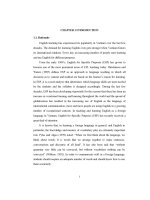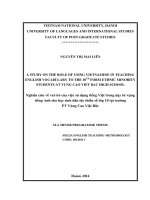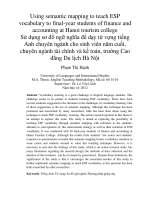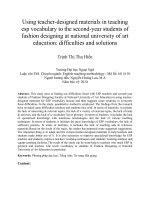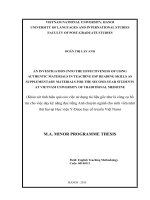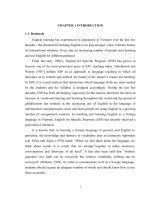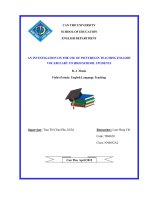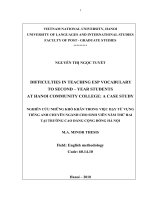Using teacher-designed materials in teaching esp vocabulary to the second-year students of fashion designing at national university of art education difficulties and solutions
Bạn đang xem bản rút gọn của tài liệu. Xem và tải ngay bản đầy đủ của tài liệu tại đây (1.39 MB, 10 trang )
Using teacher-designed materials in teaching
esp vocabulary to the second-year students of
fashion designing at national university of art
education: difficulties and solutions
Trịnh Thị Thu Hiền
Trường Đại học Ngoại Ngữ
Luận văn ThS. Chuyên ngành: English teaching methodology ; Mã Số: 60 14 10
Người hướng dẫn: Nguyễn Hoàng Lan, M.A
Năm bảo vệ: 2010
Abstract: This study aims at finding out difficulties faced with ESP teachers and second-year
students of Fashion Designing Faculty at National University of Art Education in using teacher-
designed materials for ESP vocabulary lessons and then suggests some solutions to overcome
these difficulties. In the study, quantitative method is employed. The findings from the research
have revealed some difficulties teachers and students face with. In terms of materials, it includes
the lack of interesting & relevant topics, the lack of a variety of exercise-types, the lack of tasks
& activites, and the lack of a vocabulary list or glossary. In terms of teachers, it includes the lack
of specialized knowledge with numerous teminologies and the lack of various teaching
techniques. In terms of students, it includes the poor knowledge of ESP vocabulary, the lack of
sufficient practice. In terms of facilities, it includes the lack of teaching aids & reference
materials.Based on the result of the study, the author has proposed some suggested suggestions.
The important thing is to adapt and the current teacher-designed materials to help teachers and
students make better use of it. It is also necessary to improve specialized knowledge for ESP
teachers and students, improve teachers’ teaching techniques and students’ learning method, and
equipe teaching facilities.The result of the study can be some help to teachers who teach ESP in
genreral and teachers who teach vocabulary to students of Fashion Designing at National
University of Art Education in particular.
Keywords: Phương pháp dạy học; Tiếng Anh; Từ vựng; Bài giảng.
Content:
4
TABLES OF CONTENT
Page
CERTIFICATE OF ORIGINALITY OF THE THESIS…….…………………
i
ACKNOWLEDGEMENTS………………………………………………………
ii
ABSTRACT…………………………………………………………………………
iii
TABLE OF CONTENTS…………………………………………………………
iv
LIST OF ABBREVIATION………………………………………………………
vii
LIST OF TABLES AND CHARTS…… ………………………………………
viii
PART I: INTRODUCTION………………………………………………………
1. Rationale…………………………………………………………………………
2. Aims of the study…….…………………………………………………………….
3. Research questions… ……………………………………………………………
4. Scope of the study.………………………………….……………………………
5. Methods of the study …………………………………………………………….
6. Design of the study………………………………………………………………
1
1
3
3
4
4
4
PART II: DEVELOPMENT……………………………………………………….
Chapter one: Literature review……………………………………………………….
Introduction…… ………………………………………………………………….
1.1 An overview of supplementary materials in language teaching………………
1.1.1 Supplementary materials.………………….……………………………
1.1.1.1 Definition of supplementary materials… …… …………………
1.1.1.2 The role of supplementary materials… ……………………… ….
1.1.1.3 Characteristics of supplementary materials…….….……………
1.1.2 Criteria for evaluating supplementary materials on ESP….……………
1.1.3 Material adaptation…………………….………………………………
1.1.3.1 Why are materials adapted? …………
1.1.3.2 How are materials adapted? …………
1.2 Vocabulary teaching in ESP……………………………………………………
1.2.1 Definition of vocabulary.………………………………………………
1.2.2 Main principles in vocabulary teaching………………………………….
5
5
5
5
5
5
6
6
7
8
8
9
10
10
11
5
1.2.3 The role of vocabulary teaching in ESP………………………………….
1.2.4 What need to be taught in ESP vocabulary………………………………
1.2.4.1 Word form………………………… … …… …………………
1.2.4.2 Grammar…………………………… ……………………… ….
1.2.4.3 Collocation……………………………… …….….……………
1.2.4.4 Aspects of meaning……………………….…….….……………
1.2.4.5 Word-formation….……………………….…….….……………
Summary…………………………………………………………………………….
Chapter two: Research methodology…………………………………………………
Introduction…… ………………………………………………………………….
2.1 Background of the study………………………… ………………………….….
2.1.1 The setting…………… ………………………………………………
2.1.1.1 Materials used in present teaching and learning ESP.……………
2.1.1.2 Teaching staff and vocabulary teaching methods ………………
2.1.1.3 Students and their vocabulary learning….…… …………………
2.1.2 The participants……… ………………………………………………
2.2 Research methodology……………….…………………………………………
2.2.1 Research questions … ………………………………………………
2.2.2 Method of data collection: Using the questionnaire …………………
2.2.3 Data collection procedure… …………………………………………
2.2.4 Data analysis procedure ………………………………………………
Summary…………………………………………………………………………….
Chapter three: Findings and discussion ……………… …………………………….
Introduction…… ………………………………………………………………….
3.1 Data analysis to answer the first question ………………………………………
3.2 Data analysis to answer the second question ……………………………………
3.3 Data analysis to answer the third question ………………………… …………
3.4 Findings………………………………………………………….……………….
3.4.1 Students’ difficulties in ESP vocabulary learning ……………………
3.4.2 Teachers’ difficulties in ESP vocabulary teaching …………………
3.4.3 Students’ difficulties in using teacher-designed materials for ESP
12
13
13
13
14
14
14
15
16
16
16
16
16
16
17
18
18
18
18
19
19
19
20
20
20
23
26
35
35
35
36
6
vocabulary lessons……… ………………………………………………
3.4.4 Teachers’ difficulties in using teacher-designed materials for ESP
vocabulary lessons ……………………………………………………
3.5 Possible solutions………………………………………………………………
3.5.1 Possible solutions in term of materials … …….……………………
3.5.2 Possible solutions in term of teachers…………… …………………
3.5.3 Possible solutions in term of students.…………………………………
3.5.4 Possible solutions in term of facilities…………………………………
Summary…………………………………………………………………………….
36
37
37
38
38
39
39
PART III: CONCLUSION…………………………………………………………
1. Conclusion…………… …………………………………………………………
2. Limitations and suggestions for futher study……………………………………
40
40
40
REFERENCES……………………………………………………………………
42
APPENDIX 1……………………………………………………………………….
APPENDIX 2……………………………………………………………………….
APPENDIX 3……………………………………………………………………….
I
V
X
9
PART I: INTRODUCTION
The present chapter of the thesis will be dedicated to introducing the basic
principles of a thesis including the rationale, the aims of the study as well as the research
questions. It will also present the scope, the methods and the design of the study.
1. Rationale
Nowadays, English has increasingly become one of the most popular languages
with more than five hundred million speakers all over the world. English is playing a key
role in today’s modern world because it is used as an international language in many areas
such as: science and technology, business and commerce, international relations,
diplomacy , etc. Therefore, English teaching and learning have drawn a great concern of
people in non - native nations of English. Especially, in Vietnam, English for Specific
Purposes (ESP) is being taught as a compulsory subject at many schools, colleges and
universities in the national education system.
ESP teaching at National University of Art Education (NUAE) has partly met the
students’ interest and needs. It aims at providing students with the best English learning
skills for their further study and future job. It also helps them to develop their
communication competence in English in the area they are studying.
Since 2008, NUAE have applied ESP to only students in Fashion Designing
Faculty and Art Culture Faculty with two professions: Fashion Designing and Culture
Management. Fashion Designing is not a new field in the world, but in Vietnam it has
become an important matter given much attention of people for recent years. The number
of training places for Fashion Designing is not many. NUAE is one of those places with
the purpose of training a number of Fashion Designers for the whole country.
It is undeniable that materials, including textbooks and supplementary materials,
play a very important role in teaching and learning. Many types of materials can be used
during the process of teaching and learning to provide basic knowledge to students and
improve their knowledge about and skills in the subject matter. At NUAE, ESP teaching
and learning have been ongoing for 2 years, however, there is still no official course book
for ESP. What the teachers provide students are testing materials which are edited
collection from various sources. The materials are developed solely by teachers of General
10
English at NUAE while they should be jointly developed by an expert team comprising
both teachers of English and teachers of Fashion Designing. General English teachers
select their own materials, they choose whatever is available to them and suitable to their
knowledge, thus in many cases the materials are not structurally coherent and cohesive.
Additionally, such materials have been used but no evaluation and consultation has been
conducted. Consequently, both teachers and students face many difficulties in teaching and
learning ESP, especially in teaching and learning ESP vocabulary.
Another problem adding to the lack of textbook in NUAE is the way vocabulary is
taught in the university. Although both teachers and students are well aware of the fact that
vocabulary plays an important role in learning language especially in ESP learning because
it is the element that links the four skills of speaking, listening, reading and writing all
together. The students cannot invest much time on vocabulary or have a good learning
method for the element. In the context of NUAE, the Fashion Designing students can only
get acquainted with ESP in a short time through teacher-collected supplementary materials
in which vocabulary part is not carefully designed. During this short period, teacher mainly
aims at improving reading and translating skills. Students often learn vocabulary passively
through their teachers’ explanation. It is hard for them to memorize new words, terms and
complicated expressions. The teachers share same difficulties with students in specialized
knowledge teaching, so they fail to provide every reasonable explanation.
Additionally, self study is also out of question in NUAE. ESP materials are not
easy for students to teach themselves at home as well as do exercises because the
supplementary materials have not got Answer Keys. For most of the lessons each week, the
teachers must go through 6 to 7 pages. Their main activities are helping students with
reading the text, translating the text, explaining necessary new words and correcting
exercises. Both teachers and students simply read whatever available in hand.
Consequently, their ESP vocabulary learning cannot get much improvement.
The last difficult for teachers and students in the process of ESP teaching and
learning is that they cope with the lack of various teaching technique, the lack of teaching
aids and reference materials. Tomlinson (1998: 2) defined that “language teaching
material is used to refer to anything which is used by teachers or learners to facilitate the
learning of a language”. At this level, it should be pointed out that language teaching
materials include not only course books or grammar books, as superficial thoughts of many
11
people, but also cassettes, videos, CD-ROMs, dictionaries, photocopied exercises, or
pictures prepared by teachers, which is a long way from the current supplementary
materials at NUAE, which are simply photocopied texts with exercises. As a result, both
teachers and students have trouble in their own business.
All reasons above have inspired and encouraged the researcher to carry out this
study with a hope to find out the main difficulties in using supplementary materials in ESP
vocabulary at NUAE and offer some solutions to these problems. Hopefully, suggestions
can be made to change the ways of teaching, thus to improve students’ learning
effectiveness to help them succeed in their future job.
2. Aims of the study
The study aims at:
- investigating the ESP vocabulary teaching to second-year students of teachers at
NUAE.
- investigating the ESP vocabulary learning of second-year students of Fashion
Designing at NUAE.
- finding out difficulties faced by ESP teachers and second-year students of Fashion
Designing Faculty at NUAE in using teacher-designed materials for ESP vocabulary
lessons.
- suggesting a set of teacher-designed materials for teachers and students on how to
make better use of the materials.
3. Research questions
With the aim at finding out the difficulties in teaching ESP vocabulary to the
second-year students of Fashion Designing at NUAE, the study was designed to seek
answer to the following questions:
1. What are the difficulties that the teachers at NUAE face when teaching ESP
vocabulary to second-year students of Fashion Designing?
2. What are the difficulties that the second-year students of Fashion Designing at
NUAE face when learning ESP vocabulary?
3. What solutions should be offered to help teachers and students make better use
of the teacher-designed materials?
12
4. Scope of the study
Due to the limitation of time, this study has no ambition to cover all aspects of ESP
material use. The scope of this study is limitted to the teachers’ exploitation of the
supplementary materials only. The study focuses on the investigation of difficulties in
teaching ESP vocabulary to second-year students of Fashion Designing at NUAE. The
solutions are also provided to help to improve teaching and learning English in general,
teaching and learning English vocabulary of Fashion Designing in particular at NUAE.
5. Methods of the study
The method used in the study is mainly quantitative method. In order to seek
answers to the above questions, two sets of questionnaire were designed and delivered to
the teachers and the second-year students. The data were collected, synthesized and
analyzed from the survey questionnaires on ESP vocabulary teaching and learning and
using supplementary materials. Beside, more information needed for the study was
gathered by other methods such as class observation, information discussions with the
teachers and the students at NUAE.
6. Design of the study
This study is organized into three main parts:
Part I: Introduction: In this part the rationale, the aims, the research questions, the
scope, the method and the design of the study are presented.
Part II: Development: It consists of three chapters.
Chapter 1 provides the theoretical background, which is relevant to the purposes of
the study.
Chapter 2 presents an introduction on the context of learning and teaching
vocabulary of Fashion Designing at NUAE. This chapter also includes the subjects, and the
data collection methods and data collection procedure.
Chapter 3 is the main part of the study. In this chapter, the data will be analyzed
and the finding will reveal teachers’ difficulties in using supplementary materials to ESP
vocabulary teaching to students of Fashion Designing. On the basis of these findings, the
solutions in teaching and learning will be suggested.
Part III: Conclusion: This part offers a summary of the study and some suggestions
for further study.
50
REFERENCES
1. Allwright, R. L. (1990). What do we want teaching materials for? In R.Rossner and
R.Bolitho, (Eds), Currents in language teaching. Oxford: Oxford University Press.
2. Brown, J. D. (1995). The elements of language curriculum: A systematic approach
to program development. New York: Heinle & Heinle Publishers.
3. Byrne, D. (1981). Techniques for classroom Interaction, London: Longman.
4. Cunningsworth, A. (1984). Evaluating and Selecting EFL Teaching Materials.
London: Heinemann Educational Books
5. Cunningsworth, A. (1995). Choosing your coursebook. London: Macmillan.
6. David, P (2000). Success in English Teaching. Oxford: Oxford University Press.
7. Doff, A. (1998). Teach English. Cambridge: Cambridge University Press.
8. Dulley-Evans, T. (1998). Development in ESP: A multi-disciplinary approach.
Cambridge: Cambridge University Press.
9. Harmer, J, The Practice of English Language Teaching, 3
rd
ed., Longman, Harlow.
10. Hutchinson, T & Waters, A. (1987). English for specific purposes: A learner-
centered approach. Cambridge: Cambridge University Press.
11. Johnson, K. (1982). Communicative Syllabus Design and Methodology. Oxford:
Pergamon Institute of English.
12. Karl, K. (1987). Approaches to Syllabus Design for Foreign Language Teaching,
London: Prentice Hall., Inc
13. Munby, J. (1978). Communicative Syllabus Design. Cambridge: Cambridge
University Press.
14. Nation, P (1994). New ways in teaching vocabulary. Automated Graphic System,
White Plains, Maryland: Illinois USA.
15. Nguyên, Th¸i Hoµng. (1999). Sæ tay ng-êi d¹y TiÕng Anh. Hà Nội: Nhµ xuÊt b¶n
Gi¸o dôc.
16. Nunan, D. (1988). Syllabus Design. Adelaide: Oxford University Press.
17. Nunan, D. (1991). Language Teaching Methodology. London: Prentice Hall
International.
18. Nunan, D. (1992). Research methods in language teaching. Cambridge: Cambridge
University Press.
51
19. O’Neill, R. (1990). Why use textbooks? In R.Rossner and R.Bolitho, (Eds),
Currents in language teaching. Oxford: Oxford University Press.
20. Penny, U. (1996). A Course in Language Teaching, Cambridge: Cambridge
University Press.
21. Read, A.S. (1984). Trends in Language Syllabus Design. Seameo: Seameo
Regional Language Centre.
22. Sheldon, L. (1988). Evaluating EFL textbooks and materials. ELTJ, 42(4), 237-46
23. Su, Le Van (2005). English methodology - Ph-¬ng ph¸p gi¶ng d¹y TiÕng Anh. Hà
Nội: Nhµ xuÊt b¶n V¨n ho¸ th«ng tin.
24. Swales, J. (1980). ESP: The textbook problem. ESP Journal, 1(1), 11-23.
25. Tomlinson, B. (1998). Materials development in language teaching. Cambridge:
Cambridge University Press.
26. Pyles, T.& Algeo, J. (1970). English - An introduction to Language. New York:
Harcourt, Brace.
